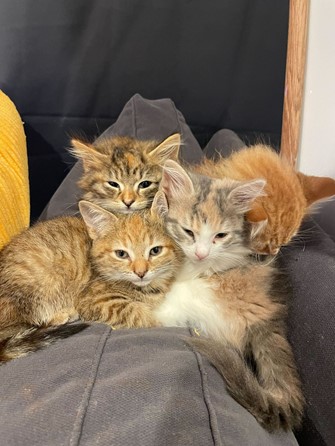Written by Copycat Staff
October 15th, 2021
Copycat's Anatomy #3

At Copycat Copywriters, our company headquarters are currently crowded with a clowder of cuddly kittens—six, to be exact.
What’s a clowder? It’s a group of cats. And while we can’t confirm that cohabitation with kitties concretely affects the quality of the copy we craft, all things cat are obviously part of our brand.
We don’t begin our client’s articles with alliterative tales or mentions of tails, but these things are aligned with our specific brand voice, which is, simply put, cute.
So, how do you figure out the voice of the brand you’re writing for? How do you capture it, and where do you highlight it? This month, we’ll be diving into the art of voice.

What is Voice, You Ask?
Voice is the way a particular brand would talk if they were a person. It’s the tone they strike with customers to convey their personality, values, and most of all, the kind of relationship they want to build.
Some companies have extensive brand guidelines describing exactly how they like to talk to customers. This can sometimes include data points like:
- Relationship – Some brands want to be your BFF. Others would rather frame themselves as your professor. While your bestie might use plenty of empathy and even inside jokes, your professor will keep things professional at all times.
- Tone – Relationships can affect tone, but there may be even more nuance to explore. Is your bestie always kind, or are they known for their teasing or tough love?
- Level of knowledge – Does the brand speak from an expert perspective, citing only peer-reviewed research? Perhaps they explain complex concepts in simple, easy-to-understand language. Or maybe they throw their hands up in the air and encourage fun over understanding the fine print.
- Cultural references and beliefs – Brands often include language and references that mirror those of their target audience. Is your brand clued into the latest pop culture references or TikTok trends? Do they have a political affiliation? A perspective on sustainability? Is it important to make the copy as inclusive as possible?
- Astrological sign, favorite color, and more – Sometimes, a brand might provide even more guidance, letting you know that they’re a sunny Leo with a penchant for pink or an edgy Scorpio with a love for all things Halloween. Or they might even tell you they have a favorite animal...
The range of potential brand personalities is somewhat more limited than that in your actual social circle—companies aren’t typically introverts—but it can run the gamut from whimsical to aggressive to serious and beyond.
Identifying a Brand’s Voice
In some cases, you’re given clear brand guidelines that outline exactly who your brand is and how they want to speak to customers—sometimes including catch phrases, favorite adjectives, and even specific guidelines on punctuation.
In others, it’s up to you to figure out the brand’s voice. For starters, you can check out the following resources:
- Website homepage and “About Us”
- Recent blog posts
- Social media captions
For bonus points, you could even subscribe to their email newsletter or check out their YouTube content. As you look over their recent assets, make mental notes about the brand persona. Keep in mind that you don’t have to like the brand personality; you just have to understand it.
Once you’ve identified the brand’s voice, the next step is figuring out how to capture it in your article.
How to Say it Like You Mean It
So you’ve figured out that you’re writing for a recycled cotton underwear brand that aims to be sexy, edgy, and irreverent—all while writing an SEO blog post on the thrilling topic of “How Long Does Polyester Take to Decompose.”
How?
If you’re not sure where to start, try implementing voice at specific parts of the writing process.
Brainstorming: From Silence to Symphony
Before you start researching, imagine where the brand’s voice and the article topic might intersect. Start with a blank piece of paper (or a blank document) and write down potential points of intersection.
At this stage, don’t worry about staying completely in the brand voice—feel free to come up with options that seem too conservative or too over-the-top. You won’t know when to rein it or amp it up until you’ve seen the full spectrum of vocal possibilities.
Introductions and Narrative Scenarios: Mic Check 1, 2, 3
Introductions should always be highly relevant to the article topic, but they’re also a great place to introduce a narrative scenario.
This often entails imagining why the reader googled the subject in the article title, and at first, very basic scenarios might come to mind for a topic like the above:
- Wondering whether you should throw out your polyester underwear?
- When underwear shopping, you might wonder which material is eco-friendly.
- Is polyester a good material for underwear?
Expand on these basic ideas to pose a question or create an anecdote spoken from the brand’s point of view.
- Wandering eye? We get it. When something lacey captivates your attention, your first impulse is to click “purchase” and make room in your underwear drawer. But if you’re ready to clear out that old polyester underwear, you might wonder…
- Your ex might be trash, but does that really mean you should throw out the teddy they gave you? If that polyester ghost of V-Day past ends up in a landfill, it might take significant time to decompose.
- When it comes to love, we’ve all heard that bright flames burn out fast. But is the same true for the fast-fashion polyester undies that serve as unwanted memories of flings past?
Headings: Your Moments of Breath
Headings should tell a coherent story, serving as a quick and easy-to-skim outline of the article.
But that doesn’t mean they have to be boring.
As you outline and write, consider where to add extra value to the headings.
For example, a simple headline like “Downsides of Polyester” can easily become “DTMF: Why You Deserve a Wardrobe Refresh.”
The Conclusion: Cue the Applause
If you’ve introduced a narrative scenario in the introduction, it should be easy to loop back to it in the conclusion to tell a complete story (again, in the same voice).
Where Voice Adds Value
Once you’ve gotten into character in your introduction, headings, and conclusions, it’s easy to take off running (and writing) in your brand’s voice.
Wondering if it’s possible to go too far with voice?
The short answer is yes.
The first purpose of an article is always to provide information that’s highly relevant to the topic outlined in the title and meta description. In some cases, voice can support this mission. In others, it distracts and detracts.
Use the following rules of thumb:
- Put research first – While it’s great to add a touch of narrative to the beginning of an H2 section, don’t get so sidetracked in fictional scenarios that you fail to address your topic. Voice is the icing, not the cake.
- Use voice to clarify – See what we did above with “voice is the icing, not the cake?” This metaphor serves as an example, not as mere decoration. Metaphors, similes, pop culture references, and specific examples can all add value—as long as they’re deployed in service of informing the reader on the topic.
- Make sure your article is still easy to scan – While headings, subheadings, and the bolded text of bullet points can serve as great places to insert some voice, make sure readers can still glean information about the article’s basic organization with a brief skim.
Talk Voicey to Us: Copycat Copywriters
At Copycat, we have our own distinct ethos and personality. To that end, we challenge any other copywriting collective to match our level of cute (again, just look at these cats).
But we also know that the trick to voice is listening with a finely tuned ear so that we can craft pitch-perfect articles that match a brand’s voice.
Want to learn more strategies to help expand your own range? Email hr@copycatcopywriters.com to subscribe to our newsletter to get more tips and tricks of the trade.